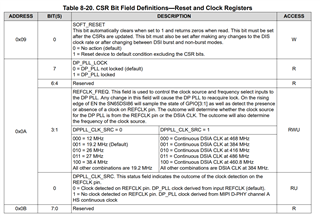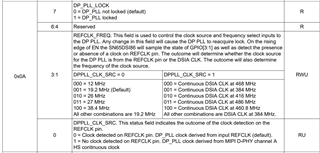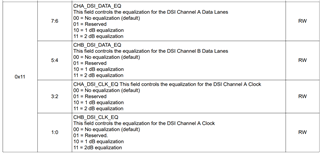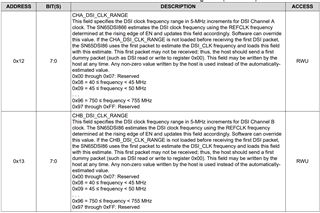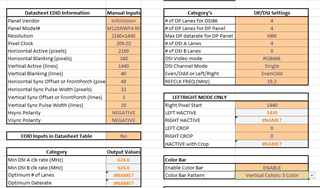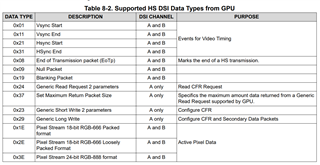HI,
I have a sn65dsi86 EVB connected to an im8mp EVB.
I'm trying to use the mipi_dsi clock (DPPLL_CLK_SRC = 1).
not getting any errors on boot but the display fails to init.
when using a "refclk" which I defined with a 27M clock the display and bridge work fine (no refclk on the target board so its not an option).
dts nodes:
mipi_dsi: mipi_dsi@32e60000 {
#address-cells = <1>;
#size-cells = <0>;
compatible = "fsl,imx8mp-mipi-dsim";
#clock-cells = <1>;
reg = <0x32e60000 0x10000>;
clocks = <&media_blk_ctrl IMX8MP_CLK_MEDIA_BLK_CTRL_MIPI_DSI_PCLK>,
<&media_blk_ctrl IMX8MP_CLK_MEDIA_BLK_CTRL_MIPI_DSI_CLKREF>,
<&clk IMX8MP_CLK_MEDIA_DISP1_PIX_ROOT>;
clock-names = "cfg", "pll-ref", "refclk";
assigned-clocks = <&clk IMX8MP_CLK_MEDIA_MIPI_PHY1_REF>;
assigned-clock-parents = <&clk IMX8MP_CLK_24M>;
assigned-clock-rates = <24000000>;
interrupts = <GIC_SPI 18 IRQ_TYPE_LEVEL_HIGH>;
power-domains = <&mipi_phy1_pd>;
status = "disabled";
port@0 {
dsim_from_lcdif: endpoint {
remote-endpoint = <&lcdif_to_dsim>;
};
};
};
sn65dsi86: sn65dsi86@2d {
compatible = "ti,sn65dsi86";
status = "okay";
reg = <0x2d>;
ti,dsi-lanes = <4>;
max,dsi-channel = <1>;
ti,dp-lanes = <4>;
pinctrl-names = "default";
pinctrl-0 = <&pinctrl_mipi_dsi_en>;
gpio-controller;
#gpio-cells = <2>;
#pwm-cells = <1>;
enable-gpios = <&gpio1 8 GPIO_ACTIVE_HIGH>;
dsi-clocks;
clocks = <&clk IMX8MP_CLK_MEDIA_MIPI_PHY1_REF>;
//clocks = <&mipi_dsi 0>;
//clock-names = "refclk";
no-hpd;
ports {
#address-cells = <1>;
#size-cells = <0>;
port@0 {
reg = <0>;
sn65dsi86_in: endpoint {
remote-endpoint = <&dsi0_out>;
};
};
};
};
};
please assist,
thanks!


